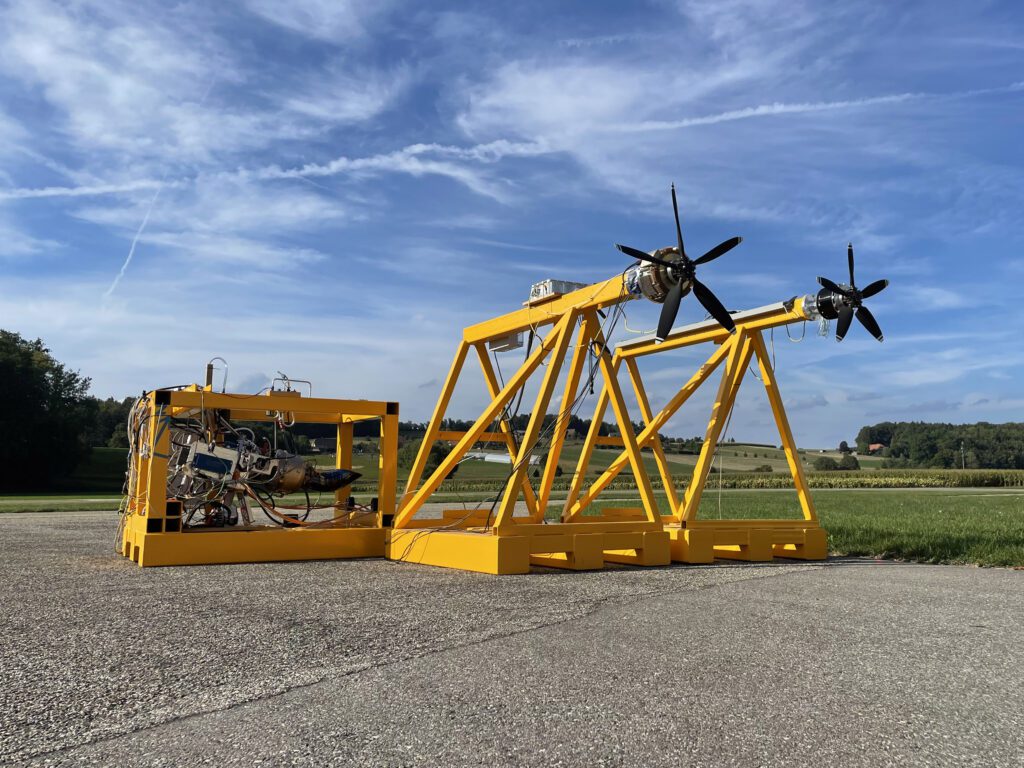
Electra, eSTOL developer, announced on Sept. 7 that it has successfully completed a fully integrated test of its hybrid-electric engine. (Photo: Electra.aero)
Electra.aero just announced that it has completed a fully integrated test of its hybrid-electric propulsion system. Electra is developing an electric short take-off and landing (eSTOL) aircraft that will initially be powered by hybrid-electric propulsion. The eSTOL will be integrated with hydrogen and battery-electric propulsion systems in the future once the technology has advanced to enable commercially viable longer-range routes for regional air mobility.
The hybrid-electric system developed by Electra includes high-power battery packs along with a turbogenerator to power the aircraft’s eight electric motors and propellers. The team conducted the engine testing at Electra’s propulsion development facility located in Switzerland.
Based in northern Virginia, Electra was founded in 2020 and is taking a long-term strategy to its approach towards sustainable aviation. At the beginning of 2022, the eSTOL developer announced that it received an undisclosed investment from Lockheed Martin to support flight testing of its technology demonstrator aircraft. Lockheed Martin also signed a strategic cooperation agreement to collaborate with Electra on various solutions for the U.S. government.
The Vice President of Electra, JP Stewart, commented on the achievement, saying that their eSTOL aircraft could enable a CO2 reduction of 5 billion tons per year by reducing the need for cars and ground transportation. “Tightly coupling airframe and propulsion systems is the hallmark of Electra’s unique and scalable approach to providing net-zero emissions for regional and transport-category aircraft by 2050,” Stewart explained.
Electra is partnering with Plug Power, a provider of hydrogen fuel cell solutions, to explore the use of green hydrogen to enable longer-range flights of its eSTOL aircraft. Plug Power initially partnered with another eSTOL developer, Airflow, until Airflow was acquired by Electra a few months ago.
Electra’s eSTOL design will require a 300-foot runway to perform its short take-offs and landings. It is expected to have a nine-passenger capacity and to fly at a cruise speed of 175 knots or approximately 201 miles per hour.

Above is a rendering of Electra’s eSTOL aircraft in flight. (Photo: Electra)
The U.S. Air Force has also shown interest in Electra’s eSTOL aircraft. Earlier this year, the USAF awarded a Phase III Small Business Innovation Research (SBIR) contract to Electra in support of continuing development of the eSTOL. The contract was awarded as part of the Agility Prime program, created to accelerate air taxi technology developments and support commercial investment.
In March, Electra and the Massachusetts Institute of Technology (MIT) were chosen to partner in developing enhanced flight controls as part of a Small Business Technology Transfer (STTR) Phase II contract from the USAF. Electra has also completed another SBIR contract from the Air Force this year—a $1.5 million direct-to-phase II contract.
Electra has also garnered interest from NASA in its eSTOL technology. In July 2021, NASA awarded an STTR contract for $125,000 to support further development of Electra’s aircraft. Dr. Alejandra Uranga from the University of Southern California’s Department of Aerospace and Mechanical Engineering was chosen as a partner to assist Electra in developing distributed electric propulsion systems.